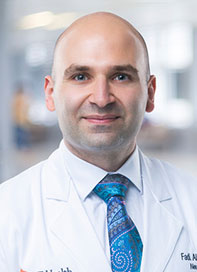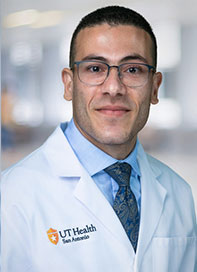Our multidisciplinary team of epilepsy specialists understands the impact epilepsy has on your life and the people you love. It’s why they’re dedicated to using their expertise and the most advanced treatment to help you take control of your life.
Treatment Options to Control Seizures
An accurate epilepsy diagnosis is the first step to controlling seizures. To determine the most effective treatment to control your seizures, our specialists use the latest technology and diagnostic procedures to pinpoint the type of seizure you’re having, where it’s located and the cause.
Intracranial Diagnostic Procedures
Stereotactic EEG (SEEG)
AN SEEG electrode placement procedure is performed by an epilepsy surgeon, who uses a robot to accurately target and position electrodes into the brain structures that are most likely causing seizures.
In some cases, the electrodes are left in place for about a week, sometimes longer, in order to record seizures. During this time your medication will be decreased or paused. Once a certain number of seizures are recorded, you will restart your medications and undergo electrocortical stimulation. This will replicate the recorded seizures confirming the exact location of where they are coming from in the brain.
You will be observed overnight and the electrodes will be removed before being discharged from the hospital. Your entire evaluation will be reviewed and discussed at the Epilepsy Surgery Case Conference.
Grid and Strip Placement
Grid and strip placement helps determine what part of the brain seizures are coming from. Grids are sheets or strips of electrodes embedded in a thin, flexible sheet of polyurethane that are implanted directly on a specific area of the brain to monitor brain activity and seizures. Grids are used to monitor a more precise area of the brain. Strips are used to monitor a larger area of the brain.
After the electrodes are in place, you’ll stay in the Epilepsy Monitoring Unit (EMU) where brain and seizure activity will be monitored to determine where the seizures occur and what functions they impact. That information is used for a second surgery to remove the grids and the area of the brain causing the seizures.
Epilepsy Medication
For 70% of people with epilepsy, medication is the solution to controlling seizures. If medication isn’t effective, we offer the most advanced nonmedical and surgical therapies to control seizures.
Nonmedical treatment options to control seizures includes methods such as, diet changes, neurostimulation, resective and disconnection surgeries.
Nonmedical Treatment Options
Ketogenic Diet
The ketogenic diet is a low-carbohydrate, adequate protein and high-fat diet used to help control seizures in children and adults, who haven’t responded to treatment with two or more anti-seizure medications. The diet will be introduced and managed by specialized dieticians working directly with your epilepsy specialist.
Resective Surgeries
Resective surgeries involve removing the part of the brain that’s causing seizures. This can include small areas (topectomies) or larger sections, like an entire lobe (lobectomies). The most common type is the temporal lobectomy.
During a temporal lobectomy, our neurosurgeon removes part of the temporal lobe (the front part of the brain used for memory, speech, emotion and visual senses) where seizures begin.
To improve results, resective surgeries are often done along with electrocorticography, which records brain activity before, during and after surgery.
Laser thermocoagulation
Laser thermocoagulation is a minimally invasive surgery used to treat deep areas of the brain that cause seizures. Our epilepsy surgeon will make a small hole in the skull and use a robot with imaging guidance to direct a laser to the problem area, avoiding damage to nearby brain tissue.
It’s commonly used to treat small tumors, brain development issues or scar tissue in areas like the amygdala and hippocampus.
Disconnecting Surgeries
Disconnection surgeries are typically for someone with larger areas of brain tissue giving rise to seizures (hemispherectomy) in one half of the brain. This can also be an option when seizures happen in both halves of the brain simultaneously or in close succession (corpus callosotomy).
Neurostimulation
Neurostimulation uses a device placed under the skin to send electrical pulses to the brain. These pulses can be delivered either on a regular schedule or only when a seizure happens.
Epilepsy surgeons use this treatment for patients whose seizures can’t be treated with brain surgery to remove the seizure-causing area.
Vagal Nerve Stimulator (VNS) Placement
A vagal nerve stimulator is implanted under the skin on your chest, similar to a pacemaker. A wire runs the VNS to the vagus nerve in your neck and will send regular, mild electrical impulses to your brain.
The procedure takes about 90 minutes and is done under general anesthesia as an outpatient surgery.
Responsive Neurostimulation (RNS) Therapy
Responsive neurostimulation (RNS) therapy uses two electrodes placed on or in the brain to record seizure activity. When a seizure or abnormal brain activity happens, the data is recorded by the patient or caregiver and is shared with an epilepsy specialist and engineers. They review the information and adjust the device’s settings as needed, so it can better detect and respond to seizures.
The device includes a small computer that tracks brain activity and sends electrical pulses to stop seizures as they start.
Deep Brain Stimulation (DBS) Therapy
Deep brain stimulation therapy was originally used to treat Parkinson’s Disease, movement and psychiatric disorders. It was eventually adapted to treat seizures beginning in both sides of the brain or widespread.
During DBS, electrodes are placed deep in the brain, in an area called the thalamus and on both sides. Wires from the electrodes are run under the skin to a small device implanted in the chest, which controls the stimulation that is being released.


